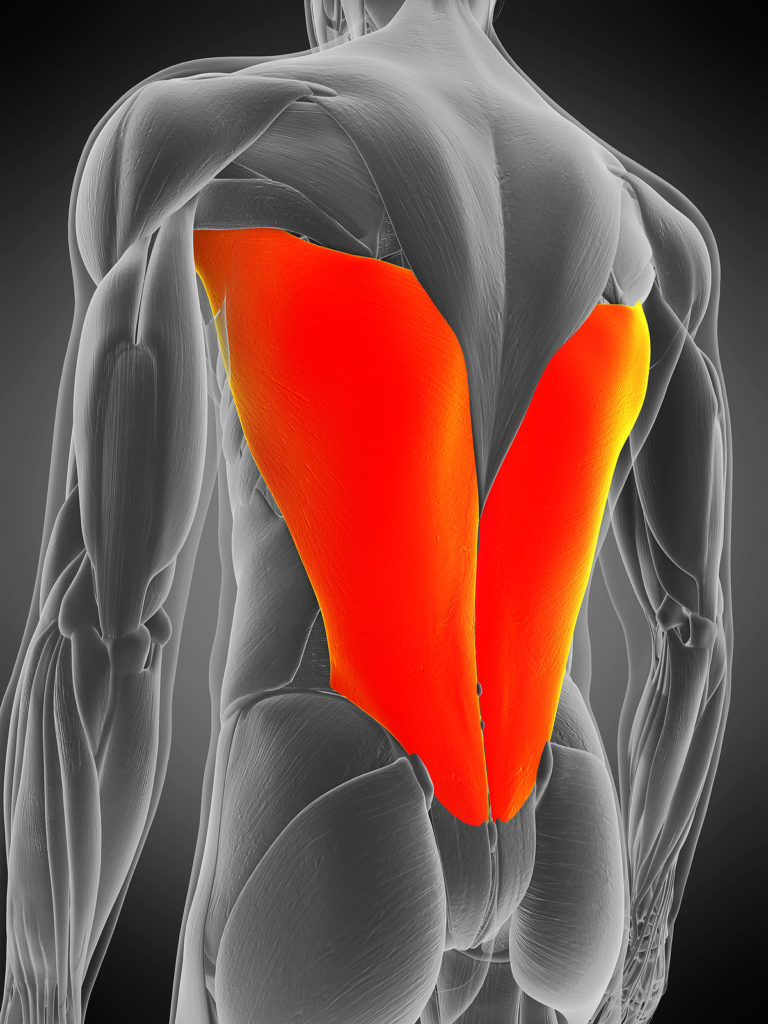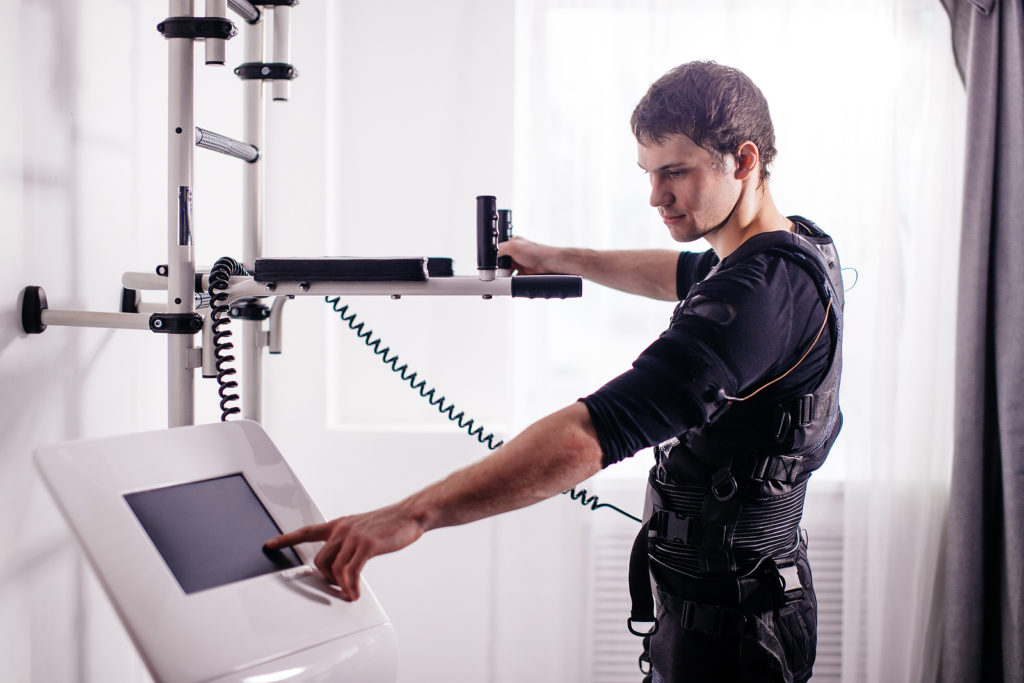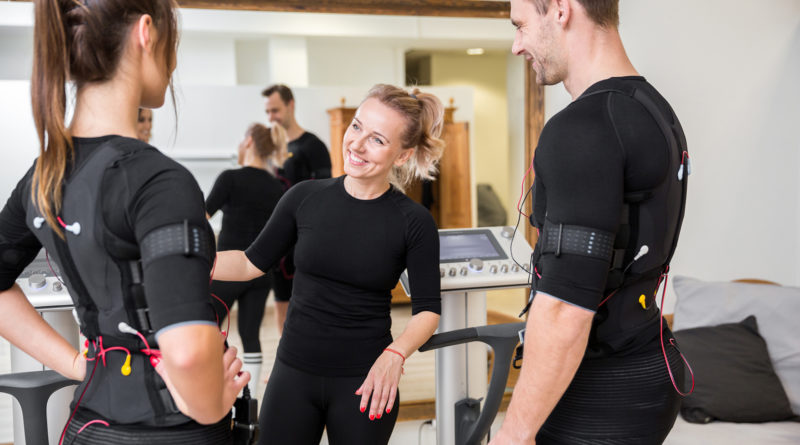EMS (Electrical Muscle Stimulation) Training: Fast Fitness or Fad?
In the hectic world we live in, many of us find it hard to fit in all the things we need to do plus all the things we *should* do to look after ourselves, like fit in enough exercise. And sometimes it’s just hard to get motivated… Which is part of the reason electrical muscle stimulation (EMS) has gone from a treatment used for patients whose specific neurological damage limits their ability to voluntarily contract muscles, to a method of enhancing fitness popularised in commercial gyms. EMS helps to maximise the muscular work and benefits in minimal time. Facilities providing it promise everything from increased strength, improved body composition and heart health, reduced back and joint pain, prevention of injuries, incontinence management, postnatal recovery, and cellulite reduction.
Key Points:
- Suits with inbuilt electrodes deliver electrical pulses to the body while exercising, increasing the force of muscle contractions.
- EMS training can increase muscle strength, size and tone, and likely improve bone mineral density, body composition, heart and metabolic health. There is no reputable reason to believe it is more effective than ‘normal’ high intensity resistance training… but it may be more efficient.
- Against this efficiency you have to weigh the possible risk of stimulated contractions being excessive- possibly leading to rhabdomyolysis, a serious state of muscle destruction that can lead to diseases. Opting for a facility that tailors stimulus settings to suit you and is run by well trained professionals will help.
- Despite claims by the industry, I found little to no evidence that it helps with back pain, incontinence management, postnatal recovery or cellulite reduction.
How does EMS training work?

EMS can be used alone (this mode generally used in clinics), but in the commercial setting it is more commonly used to enhance muscle contraction while you’re training. Electrodes are placed on the skin to send electrical impulses to motor nerves, thereby causing your muscle to contract. In gyms, several electrodes are built into suits with silicone conductive pads, and wireless technology allows people to move within 40m of the person/computer responsible for sending highly regulated zaps your way. Up to 12 muscle groups may be simultaneously stimulated (upper legs, upper arms, bottom, abdomen, chest, lower back, upper back, latissimus dorsi, and 4 free options) with different selectable intensities.
EMS suits can target up to 12 muscle groups (including latissimus dorsi, pictured) to increase contraction force. Image credit: SciePro https://www.bigstockphoto.com/
The pattern of muscle contraction is different than voluntary contractions. When you’re doing any resistance training without EMS, small groups of muscle cells will initially fire (primarily slow-twitch fibres which exert low force). As the need for force increases, more and stronger groups of muscle cells are recruited. With EMS, a larger motor nerve is initially stimulated, leading to immediate firing of powerful fast-twitch muscle fibres and the simultaneous activation of more motor units than usual. Muscle contraction is less efficient thanks to these changes, and people are more susceptible to neuromuscular fatigue than in regular exercise.
Interestingly, a small study of 52 ill patients found that muscle strength was preserved not only in the legs, which were electrically stimulated, but also in some (but not all) muscles in the arms, which were not stimulated. So, EMS may have a systemic effect. However, the study was limited by its small size and the fact that people were aware of what treatment they were getting, which can bias results.
Effects of EMS training
Increased muscular strength
An increase in muscle strength, size and/or tone would be one of the most obvious motivators for EMS training. Indeed, it can achieve these things. However, the research is yet to convince that EMS training provides superior strength increases to that of regular high intensity resistance training.

Commercial facilities have advertised results up to 18 times greater than conventional resistance training. This is a gross misrepresentation of the science though. There have been instances when creatine-kinase (CK) levels in the blood have been demonstrably highly elevated after a (too) intense initial EMS application. However, these elevations have not been matched by proportional muscle mass, strength or other gains. In fact, such high CK levels in these cases are more likely a marker of danger… more on this later.
Where EMS training does stand out- in a good way- is its efficiency. In a 16-week study, similar improvements were produced from 3 sessions/fortnight of whole body EMS compared to approximately 2-3 x 30 minute high intensity resistance training sessions per week) in a group of healthy but untrained 30-50 year old men. These findings cannot be mindlessly generalised, as the study has limitations including a small number of participants. In addition, chances are a high intensity resistance training program you would undertake would differ from the one studied- as would the EMS protocol selected by a gym you walked into differ from the one in used by these researchers… and again, the comparison between the work load of your regular resistance training and that of your selected gym would differ. That is to say, a) further research into the effect of EMS on strength gains is required, and to delineate the relationship between EMS protocol and strength responses, and b) your EMS training may produce more or less pronounced increases in strength relative to your resistance training, yet c) EMS training appears a time-efficient way to increase strength.
Both regular resistance training and EMS produce adaptations in the nervous system which increases strength, before any muscle gains occur. However, since EMS and regular training stimulate the nervous system differently, the neural adapatations are also likely to differ. From research, it appears that EMS stimulates movement planning and execution parts of the brain. Furthermore, if the left leg is electrically stimulated, the right will show some adaptation. There is debate as to whether the adaptations may also be related to muscle activation and increased spinal excitability, so this area should be further explored.
Reduced back pain
A retrospective meta-analysis of studies showed that EMS did reduce the frequency and intensity of back pain. However, only 45 people met criteria for inclusion in this analysis, so further randomised controlled trials are required to substantiate this claim. In addition, these findings were based on self-report questionnaires, which by nature are subjective and may be contain inaccuracies.
Body composition, heart and metabolic health

There are mixed results regarding whether EMS training alone can reduce risks associated with cardio-metabolic diseases. Improvements in waist circumference, skin fold measurements, muscle mass and body composition as determined by dual energy X-ray absorptiometry (DEXA scans), have been found in several small studies in a number of populations. The improvements in body composition again appear to be similar to those obtained through regular resistance training. In one study, some improvements in mean arterial pressure (a measure of blood pressure) have also cited, but there was no significant effect of EMS on cholesterol. Small studies have also suggested reduced heart disease risk and increased oxygen consumption (related to energy expenditure).
In the above mentioned study of healthy but untrained 30-50 year old men, EMS and resistance training also produced similar improvements in body composition.
Bone mineral density
A high bone mineral density is crucial in the prevention of osteoporosis and fractures. A study showed that EMS training increases bone mineral density; but again, this is at a similar level to other resistance training. As bones adapt to training more slowly than muscles do, longer-term studies could provide more information.
I found no research directly examining the value of EMS training in incontinence management, postnatal recovery or cellulite reduction.
Safety
Like any intense exercise, indeed anything in life, there are some risks involved in EMS training.
One of the most significant risks is severe rhabdomyolysis. It is normal for muscle cells to get microtears in resistance training, resulting in DOMS. The repair of these tears allow the muscle to get bigger and/or stronger. However, when the intensity is excessive, rhabomyolysis may occur- otherwise known as muscle death or destruction. As muscle cells are destroyed, they spew their contents into the blood stream, including creatinine kinase (CK). Remember those commercial EMS providers who boast about the “18 times greater results” they can provide in comparison to conventional training, but who in fact are talking about the CK levels?… That’s right, they can provide up to 18 times the muscle damage!! To be fair, CK levels will increase in proportion to manageable muscle damage as well- but when it becomes so high, it’s a marker of destruction.

As EMS activates a large area of muscle with a high current, it is very possible for the intensity to be too extreme- particularly in the early/initial EMS sessions, when the body may not be sufficiently adapted. Thus the best way to avoid this, is the application of caution: do not allow yourself to reach the point of exhaustion. It is also crucial that you drink extra fluids to stay hydrated and avoid renal stress.
Image credit: Ribbon vector created by gstudioimagen – www.freepik.com
Like a researcher dedicated to equipping you with the fullest information, I gave myself a case of rhabdomyolysis last year (through non-EMS means). Let me assure you, it’s nasty. You do not want it. With the muscle breakdown, and the CK and other chemical release into your bloodstream, a bunch of fluid and macrophages were sent to my arms in an attempt to clean up the debris. This led to painful swelling to the point where I could not bend my elbows, as my inflated upper and lower arms soon rubbed together. More seriously, the bodies’ attempt remove all of the chemicals that have been thrown into the blood puts incredible strain on the kidneys, and can lead to kidney failure. Cardiac arrest, liver and other serious complications can also arise if rhabdomyolysis is not promptly managed. I was fortunate to avoid these by going to hospital quickly enough, and spending a couple of days being pumped with an obscene volume of IV fluid to flush out the system, another week of drinking ridiculous amounts once home, and a long period of impaired strength afterwards.
The good news is that with regular sensible EMS training people do adapt, and they are less likely to experience muscle damage in subsequent sessions. However, there is inadequate evidence on the chronic effect of repeated EMS sessions on risks, so it is recommended that you allow yourself plenty of time to recover and adapt by limiting yourself to one training session per week during the first 8-10 weeks. After that initial conditioning phase, it’s recommended that you allow 4 or more recovery days between each training session to avoid accumulation of CK and other breakdown products, and allow growth and repair.
Other precautions include ensuring that you are in good physical condition when performing EMS training, without fever, to not be under the influence of alcohol, drugs, muscle relaxants or stress, and to avoid exercises that cause pain. You should ensure you are well fed with carbohydrates as EMS is metabolically demanding; in the least it’s recommended you eat a high carbohydrate but like snack of approximately 250 calories, a couple of hours before a session.
The effect of EMS stimulus settings on the body

EMS settings can and should be customised to reduce fatigue and optimise force output, ensuring both safety and success. It is vital that instructors also are well trained and have a strong understanding of the stimulation settings. Settings to be considered include the frequency of stimulation, pulse width/duration, duty cycle, intensity/amplitude, ramp time, pulse pattern, program duration, program frequency, and muscle group activated.
Image credit: ufabizphoto https://www.bigstockphoto.com/
There have been a small number explicit parameter recommendations for general health and fitness purposes recently. However the majority of recommendations I found tended to have a clinical rehabilitation focus. These, supplemented with the settings safely and effectively used in research papers suggest a:
- Duration of 20 minuntes
- Frequency of stimulation of 85 Hz (85 pulses per second).
- For clinical rehabilitation purposes a frequency of 20-50 Hz is often used, however it can vary widely according to task.
- Higher frequencies can produce more force and, in general, are more comfortable and may produce a tingling sensation. At lower frequencies some people may feel the tap of individual pulses.
- 350 μsec pulse width.
- Wider pulse widths may produce stronger contractions with less fatigue. Different motor units are activated, meaning the workload is shared among more nerves and muscle cells.
- A rectangular pulse pattern
- 6 seconds of current, interspersed with 4 seconds of rest
- A comfortable intensity or amplitude.
- The amplitude of the stimulation can have two, contrasting, effects on contraction force. Higher amplitudes mean more muscle fibres are stimulated. However, ‘antidromic transmission’ of the signal can occur (i.e. toward the cell body rather than normal orthodromic transmission away from the cell body). This blocks both motor and sensory impulses from the spinal motor pool, resulting in less overall activation of the central nervous system. Higher intensities are also generally less comfortable and less tolerated.
- Customised ramp times
- Ramp time is the time it takes the stimulation to get to the desired frequency. In rehab, ramp times of 1-3 seconds or more are commonly used. Modifying of ramp times is useful in movements involving multiple, large muscle groups (such as those performed in gyms) so that the coordination of muscle activation replicates natural movement.
In an effort to see how well commercially available programs aligned with settings that have been safely and effectively used in current research, I contacted a number of facilities providing EMS training in Sydney, New York and London. None of the facilities were able to disclose this information for proprietary or other reasons.
The Verdict
In summary, EMS training is a good option to improve or maintain muscle mass, strength, and cardiac and metabolic health when you’re on a time limit. In face of the lack of information regarding the symmetry between research recommendations and commercial providers’ stimulation settings, the sensible move would be to opt for a provider who is able to individualise their programs. If you use caution to avoid the elevated risk of rhabdomyolysis- checking with your doctor of suitability of this training for you, not exercising to exhaustion, and building up slowly- it may be a fitness fad that pays dividends for you.
Have you tried EMS training? We'd love to hear about your experiences!
References
Doucet, B. M., Lam, A., & Griffin, L. (2012). Neuromuscular electrical stimulation for skeletal muscle function. The Yale journal of biology and medicine, 85(2), 201-15.
Herzig, D., Maffiuletti, N.A., and Eser, P. (2015). The Application of Neuromuscular Electrical Stimulation Training in Various Non-neurologic Patient Populations: A Narrative Review. PM&R, 7(11). https://doi.org/10.1016/j.pmrj.2015.03.022.
Hortobágyi, T., and Maffiuletti, N.A. (2011) Neural adaptations to electrical stimulation strength training. European Journal of Applied Physiology. 111: 2439. https://doi.org/10.1007/s00421-011-2012-2
Jee Y. S. (2018). The efficacy and safety of whole-body electromyostimulation in applying to human body: based from graded exercise test. Journal of exercise rehabilitation, 14(1), 49-57. doi:10.12965/jer.1836022.011
Karatzanos E, Gerovasili V, Zervakis D, et al. (2012) Electrical muscle stimulation: an effective form of exercise and early mobilization to preserve muscle strength in critically ill patients. Crit Care Res Pract. 432752.
Kemmler, W., Froehlich, M., von Stengel, S, and Kleinoder, H. (2016) Whole-body electromyostimulation – The need for common sense! Rationale and guideline for a safe and effective training. Dtsch Z Sportmed. 67:218–221.
Kemmler, W., Schliffka, R., Mayhew, J.L., and von Stengel, S. (2010). Effects of whole-body electromyostimulation on resting metabolic rate, body composition, and maximum strength in postmenopausal women: the Training and ElectroStimulation Trial. J Strength Cond Res. 24:1880–1887.
Kemmler, W., and von Stengel, S. (2013) Whole-body electromyostimulation as a means to impact muscle mass and abdominal body fat in lean, sedentary, older female adults: subanalysis of the TEST-III trial. Clin Interv Aging. 8:1353–1364.
Kemmler, W., Kohl, M., and Stengel, S. (2016) Effects of High Intensity Resistance Training versus Whole-Body Electromyostimulation on Cardio-Metabolic Risk Factors in Untrained Middle-Aged Males. A Randomised Controlled Trial. Journal of Sports Research, 3(2): 44-55
Kemmler, W., Kohl, M., and von Stengel, S. (2016) Effects of High Intensity Resistance Training versus Whole-Body Electromyostimulation on Cardio-Metabolic Risk Factors in Untrained Middle-Aged Males. A Randomised Controlled Trial. Journal of Sports Research, 3(2): 44-55
Kemmler, W., Froehlich, M., von Stengel, S., Kleinöder, H. (2016) Whole-Body Electromyostimulation – The Need for Common Sense! Rationale and Guideline for a Safe and Effective Training. Dtsch Z Sportmed. 67: 218-221. DOI: 10.5960/dzsm.2016.246
Kemmler, W., Teschler, M, Weißenfels, M., et al. (2016). Effects of Whole-Body Electromyostimulation versus High-Intensity Resistance Exercise on Body Composition and Strength: A Randomized Controlled Study. Evidence-Based Complementary and Alternative Medicine, vol. 2016, Article ID 9236809, 9 pages, 2016. https://doi.org/10.1155/2016/9236809.
Kemmler, W., Weissenfels, A., Bebenek, M. et al. (2017) Effects of Whole-Body Electromyostimulation on Low Back Pain in People with Chronic Unspecific Dorsal Pain: A Meta-Analysis of Individual Patient Data from Randomized Controlled WB-EMS Trials. Evidence-Based Complementary and Alternative Medicine, vol. 2017 https://doi.org/10.1155/2017/8480429.
Teschler, M., Weissenfels, A., Fröhlich, M., Kohl, M., Bebenek, M, von Stengel, S., Kemmler, W. (2016) (Very) high creatine kinase (CK) levels after Whole-Body Electromyostimulation. Are there implications for health? Int J Clin Exp Med 9(11):22841-22850 www.ijcem.com /ISSN:1940-5901/IJCEM0032422
von Stengel, S. , Bebenek, M., Engelke, K., and Kemmler, W. (2015). Whole-Body Electromyostimulation to Fight Osteopenia in Elderly Females: The Randomized Controlled Training and Electrostimulation Trial (TEST-III). Journal of Osteoporosis, vol. 2015, Article ID 643520, 7 pages, 2015. https://doi.org/10.1155/2015/643520.
Wittmann, K., Sieber, C., von Stengel, S., Kohl, M., Freiberger, E., Jakob, F., … Kemmler, W. (2016). Impact of whole body electromyostimulation on cardiometabolic risk factors in older women with sarcopenic obesity: the randomized controlled FORMOsA-sarcopenic obesity study. Clinical interventions in aging, 11, 1697–1706. doi:10.2147/CIA.S116430
